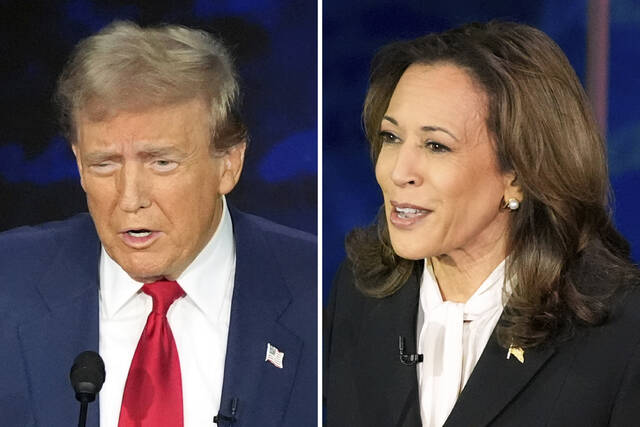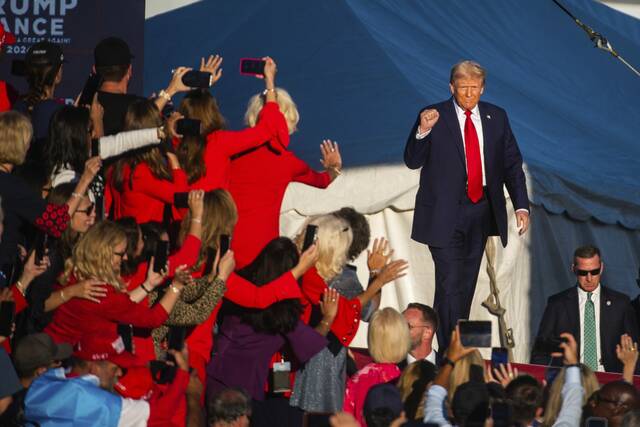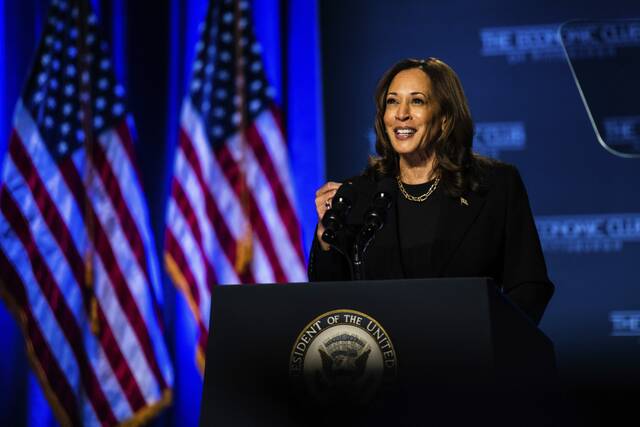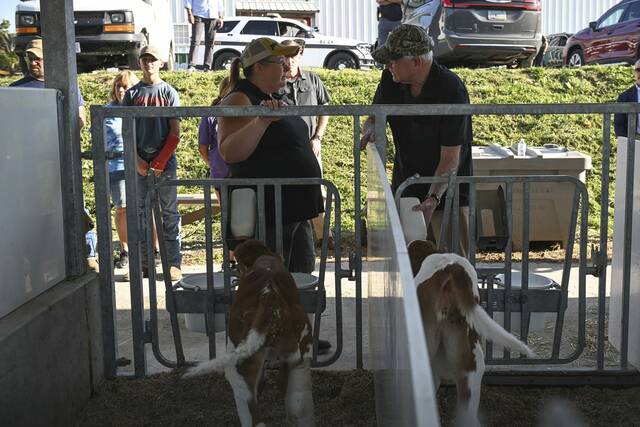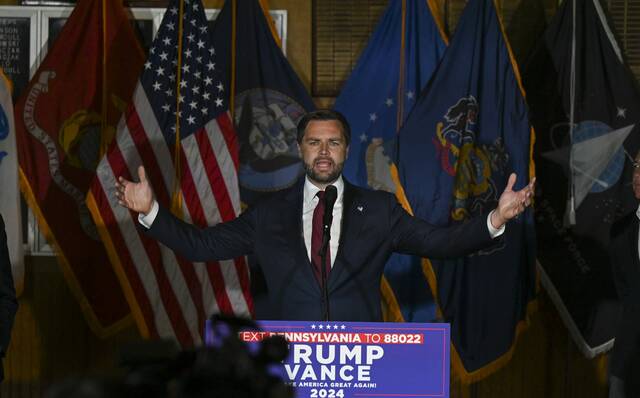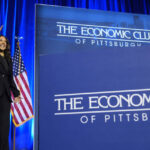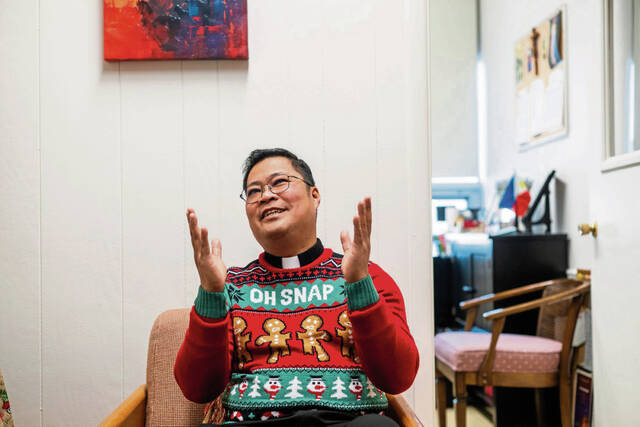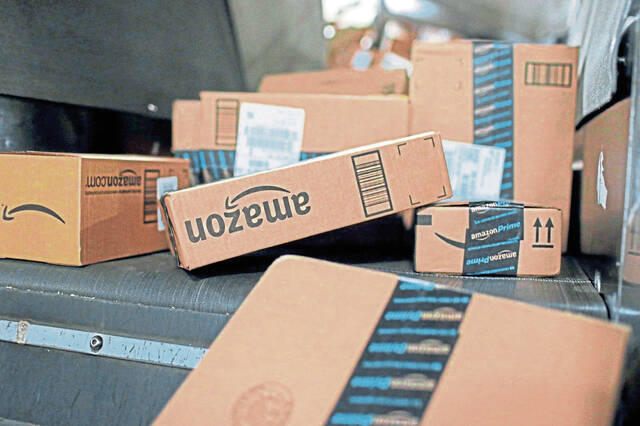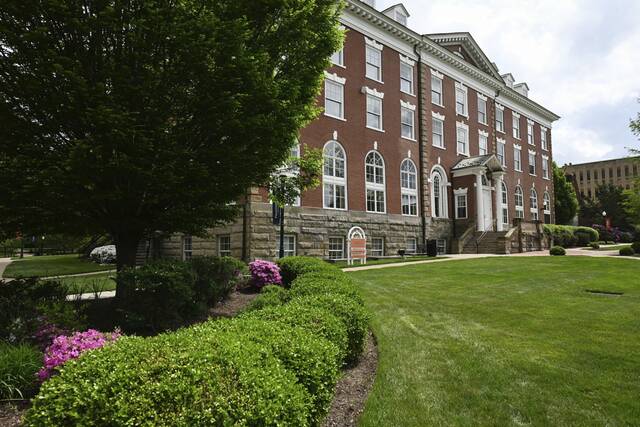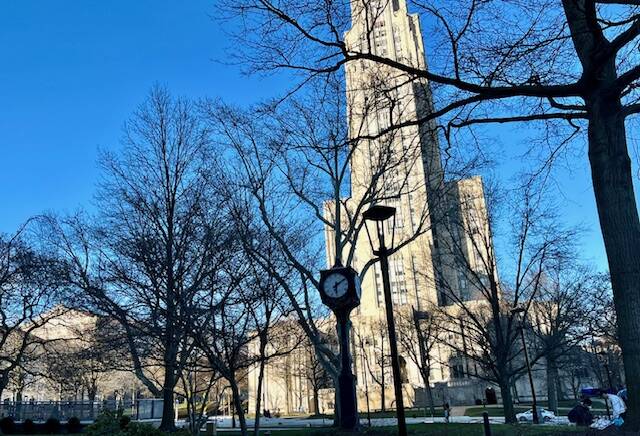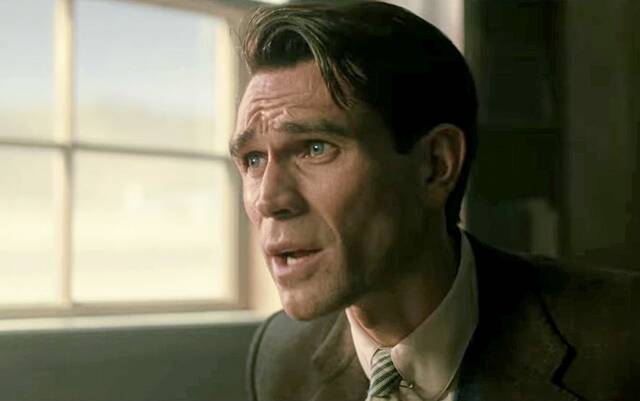Forget spotted lanternflies, controversial restaurant visits or even an assassination attempt.
Whatever peculiar problems the Pittsburgh region might pose, Kamala Harris and Donald Trump just can’t stay away.
With 19 precious Electoral College votes at stake in Pennsylvania, the world’s two most-watched politicians have crisscrossed our area over the past several months, making it almost a second home as they duel for the presidency.
Harris, Trump and their running mates have visited Southwestern Pennsylvania more often than anywhere else in America since July — about 15 times in all.
They’ve toured local icons like Primanti Bros., fed a calf, paid for groceries and held a town hall. And they’ve endured the bad with the good.
Despite being wounded in the ear by a bullet at a July rally in Butler County, Trump made a triumphant return one week ago to the scene of the crime. Harris’ viral encounter last month with a lanternfly, one of the state’s most-hated pests, isn’t likely to deter her from returning. Both Harris and Trump’s running mate, Ohio Sen. JD Vance, shrugged off poor optics surrounding stops at Primanti Bros. and forged ahead.
The candidates’ focus on the region underscores how critical every last vote is to their chances of winning the White House in November.
Beyond campaign events, hundreds of millions of dollars of political ads are bombarding the Pittsburgh region, arguably as much as anywhere in the nation.
All the fuss has generated all the feels among Pittsburghers — a mixture of pride, stress, annoyance and humor. And no wonder.
Pundits believe the path to the presidency runs through Pennsylvania. So far, the fraught battle has been neck-and-neck. Going into the home stretch, experts predict wafer-thin margins and a nail-biting finish.
It’s all converging to make Pittsburgh the center of the political universe.
Experts chalk that up to Pennsylvania’s status as the most crucial swing state in the nation, Southwestern Pennsylvania’s growing influence in Democratic and Republican circles and the campaigns’ slightly different strategies.
Not many other regions in America have come close to being as much of a magnet for the candidates.
The Detroit area in the battleground state of Michigan is the second most visited after the Pittsburgh region. Candidates have visited 10 times since July. The country’s auto manufacturing hub is the only other metro area to break double-digit visits.
Chris Borick, a political science professor at Muhlenberg College in Allentown, said he has followed campaigns in Pennsylvania for decades and can’t remember Pittsburgh ever getting this much attention.
In fact, Pittsburgh already has had more campaign visits this year than during any presidential election year dating to 2004, according to an analysis by TribLive.
“It seems every time I turn around, one of the candidates is in Pittsburgh,” Borick said. “The level of the visits and all the ad buys, they have taken it to a whole other level.”
Numbers game
For Arthur Mueller, 28, of Squirrel Hill, presidential attention normally would trigger excitement, but he said all the visits have been a bit of overkill. Mueller is supporting Harris and has voted in every election since turning 18.
He said he understands politics enough to know the campaign barrage here is mostly a numbers game, considering Pennsylvania’s status as the biggest swing state. The region also has a big chunk of Republicans and Democrats who each candidate feels are crucial to victory.
“At this point, I just want to be left alone,” Mueller said. “Every time I see news about another campaign visit, it serves as a reminder that this is all just a numbers game and we’ve all been reduced to numbers that just happen to matter more than numbers in other parts of the country.”
Mitchell Nagy, 28, of Pittsburgh’s South Side Slopes neighborhood said the visits have given him a sense of pride.
He is supporting Harris and said he was thrilled to see her stay at the Omni William Penn hotel in Downtown Pittsburgh in September, when she spent five days prepping for her Sept. 10 debate in Philadelphia against Trump.
Nagy said it fulfilled a long tradition of presidential candidates staying at the historic hotel.
“It adds to that history and legacy. Pittsburgh has always been an impactful place, and this continues that,” said Nagy, who works in the energy sector. “Partisan politics aside, it is cool to have locals get a chance to engage directly with the candidates.”
Mike McMullen, 54, is a consultant from Gibsonia and a Republican who is supporting Trump. He was a delegate to the Republican National Convention in July in Milwaukee.
He said the outsize attention from the candidates serves to remind Pittsburghers how important the region is for Republicans.
Southwestern Pennsylvania boasts the largest share of Republican voters of any region in the state. Combine that with Allegheny County growing as a Democratic stronghold, and it has an intense gravitational pull for both candidates and their parties.
“Pittsburgh is the center of the universe,” McMullen said. “I think it is even going to be more so as we get closer to the election.”
Ad deluge
Mueller said he can stomach the visits, but the campaign ads have driven him crazy.
The Pittsburgh media market — which includes 12 Southwestern Pennsylvania counties surrounding the city — has accrued more than $213 million in political ads this year, according to advertisement tracker AdImpact.
That’s the fifth most in the country, despite Pittsburgh being significantly smaller than other top political media markets, such as Philadelphia, Phoenix and Detroit.
Another $53 million has been spent in the neighboring Johnstown-Altoona media market.
Pennsylvania as a whole has attracted nearly $1 billion in political ad spending this year, an astounding figure that has broken records. Ads include commercials on broadcast and cable television, streaming content, radio and websites.
“The thing that is really driving me up the wall is the inescapable deluge of political advertising,” Mueller said. “In a normal year, any time I’m home on a Saturday, I’d be watching college football. This year, I’m just so sick of political ads I’m pretty much only watching Pitt games on mute.”
Main event
Pennsylvania has long been a swing state, but not always the most important.
During former President Barack Obama’s campaigns in 2008 and 2012, Florida and Ohio attracted the candidates more often and received more advertising attention.
Both of those states have shifted red in subsequent years.
Now, Borick said, Pennsylvania is the main event.
“Pennsylvania used to be fool’s gold for Republicans,” Borick said, noting Republican candidates like John McCain or Mitt Romney would spend millions to campaign here only to come up short.
Trump changed that in 2016, Borick said, by flipping the state red for the first time in 28 years.
Lew Irwin, a political science professor at Duquesne University, said the frequency and volume of candidate visits to Southwestern Pennsylvania over the past two months is expected, given the importance of the region to winning the state’s electoral votes.
“There’s no question the road to the White House runs through Western Pennsylvania. It’s almost impossible to see a path for Donald Trump to win without winning Pennsylvania,” Irwin said.
Irwin said those “persuadable voters are mostly suburban women who live in the collar counties surrounding Pittsburgh and Philadelphia. The campaigns are seeking to make personal connections in an effort to earn their support in a race pollsters say carries a razor-thin margin.”
Pittsburgh powerhouse
While the Keystone State has been the key to presidential campaigns since 2016, this year, Pittsburgh has emerged as the most important region in the commonwealth, supplanting Philadelphia and Southeastern Pennsylvania.
In 2016, Pennsylvania attracted an astounding 60 visits from presidential candidates Trump and Democrat Hillary Clinton, mostly in the Philadelphia area. The Pittsburgh area attracted only 14 visits that year, mostly by Trump.
Pennsylvania has seen more than 30 visits from candidates this year, with the southwestern part of the state receiving the most of any region.
That doesn’t count the high-profile surrogates who have descended upon Pittsburgh to support their candidates.
Former President Barack Obama rallied for Harris in Oakland last week. First lady Jill Biden visited the region several times this year. And Transportation Secretary Pete Buttigieg touted infrastructure projects in January.
Billionaire Elon Musk rallied with Trump in Butler in early October, then attended a home Steelers game the next day. Musk will crisscross the state in support of Trump this month.
Jacob Rubashkin, deputy editor at national election research group Inside Elections, said it is unsurprising to see Pittsburgh getting more attention than Philadelphia this cycle.
He noted that Allegheny County provided more total votes than Philadelphia in 2022, despite having a smaller overall population.
President Joe Biden also did historically well in Allegheny County, outmatched by only two Democratic juggernauts: former Presidents Franklin D. Roosevelt and Lyndon Johnson. That 2020 performance signaled to campaigns that Southwestern Pennsylvania needs more attention, Rubashkin said.
Allegheny County has about two registered Democrats to every one registered Republican, but the county is still home to more Republican voters than any in Pennsylvania.
“Allegheny County is the more competitive county. There are Republican votes to get there,” Rubashkin said. “From an efficiency standpoint, you are going to go where there are more winnable votes.”
Scrounging for votes
Tim Hagle, a political science professor at the University of Iowa, has experienced how the steady flow of candidate visits can impact a presidential race.
For years, Iowa has been home to the first stop in the presidential nomination process. Candidates flock to the state months, and sometimes a year, before the caucuses that often set the stage for the race.
“It’s fruitful for them, for both voters and the candidates to come out, to look people in the eye and tell them where they stand. It allows the candidate to understand the voters, and the candidates need to handle that,” Hagle said.
The visits can make a difference in Pennsylvania, Borick said, because the state has had such close contests over the past two presidential cycles, and this year’s race is expected to be more of the same.
Borick noted that Harris and Trump have placed a focus on Johnstown. For Trump, that means boosting his already-strong support there. He won Cambria County, home to Johnstown, by more than 37 percentage points in 2020.
For Harris, the goal is to try to earn votes back from people who used to support Democrats. Obama narrowly won Cambria County in 2016.
Borick also noted that Harris is likely trying to avoid the mistakes made by Hillary Clinton, who was criticized for ignoring voters in blue-collar industrial towns like Johnstown.
“The candidates are putting in efforts beyond their traditional base areas to find those marginal voters,” Borick said. “Even if a Democrat can get a 2-point gain in a place like Cambria County, it is worth it because the state is so close.”
Buckle up
Don’t expect Pittsburgh to get much of a break from the candidates as Election Day on Nov. 5 approaches, Irwin said.
Biden, Trump and their running mates campaigned several times combined in the Pittsburgh area in the last two weeks of the 2020 campaign.
As the race reaches its final stages, the visits are expected to continue unabated.
Political experts said both campaigns are looking to convince any remaining undecided voters and energize their bases to get out the vote, Irwin said.
“You’re going to see every visit that is logistically feasible for them,” Irwin said. “It’s a matter of when they can get here.”


